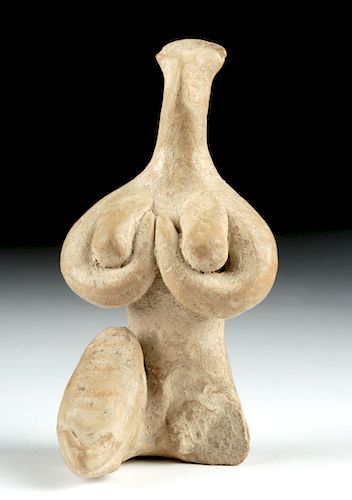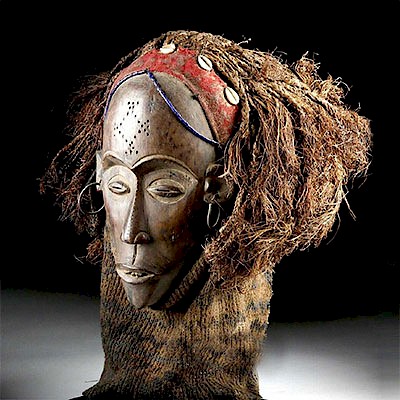Tell Halaf Pottery Seated Mother Goddess w/ TL
Lot 42
About Seller
Artemis Gallery
686 S Taylor Ave, Ste 106
Louisville, CO 80027
United States
Selling antiquities, ancient and ethnographic art online since 1993, Artemis Gallery specializes in Classical Antiquities (Egyptian, Greek, Roman, Near Eastern), Asian, Pre-Columbian, African / Tribal / Oceanographic art. Our extensive inventory includes pottery, stone, metal, wood, glass and textil...Read more
Estimate:
$900 - $1,400
Absentee vs Live bid
Two ways to bid:
- Leave a max absentee bid and the platform will bid on your behalf up to your maximum bid during the live auction.
- Bid live during the auction and your bids will be submitted real-time to the auctioneer.
Bid Increments
| Price | Bid Increment |
|---|---|
| $0 | $25 |
| $300 | $50 |
| $1,000 | $100 |
| $2,000 | $250 |
| $5,000 | $500 |
| $10,000 | $1,000 |
| $20,000 | $2,500 |
| $50,000 | $5,000 |
| $100,000 | $10,000 |
| $200,000 | $20,000 |
About Auction
By Artemis Gallery
Apr 4, 2019
Set Reminder
2019-04-04 10:00:00
2019-04-04 10:00:00
America/New_York
Bidsquare
Bidsquare : Ancient / Ethnographic From Around The World
https://www.bidsquare.com/auctions/artemis-gallery/ancient-ethnographic-from-around-the-world-4003
Ancient art from Egypt, Greece, Italy and the Near East, as well as Asian, Pre-Columbian, Native American, African / Tribal / Oceanic, Spanish Colonial, Russian Icons, Fine art, much more! All categories, all price ranges... all legally acquired and guaranteed to be as described or your money back Artemis Gallery info@artemisgallery.com
Ancient art from Egypt, Greece, Italy and the Near East, as well as Asian, Pre-Columbian, Native American, African / Tribal / Oceanic, Spanish Colonial, Russian Icons, Fine art, much more! All categories, all price ranges... all legally acquired and guaranteed to be as described or your money back Artemis Gallery info@artemisgallery.com
- Lot Description
Ancient Near East, Anatolia (central Turkey) or northern Syria, Tell Halaf area, ca. 6500 to 4500 BCE. A lovely pottery fertility figure depicting a seated woman with voluptuous breasts held aloft by curved arms and thighs that emphasize her fruitfulness. She features sloping shoulders which taper inward to a slender neck, and her rod-shaped head displays only a prominent pinched nose and a pinched coiffure. Faint traces of original orange pigment are visible along the legs, arms, and breasts. As early as the 7th millennium BCE, cultures in the Near East began creating organized settlements with highly developed religious as well as funerary practices. The Halaf culture of Anatolia (central Turkey) and northern Syria produced mesmerizing female figurines with fertility attributes. Whether images like these were intended to represent real, ideal, or divine women is unknown; however, scholars believe that their primary purpose was to encourage female fertility. Size: 1.9" W x 3.8" H (4.8 cm x 9.7 cm).
For a stylistically-similar example, please see The Brooklyn Museum, accession number 1990.14: https://www.brooklynmuseum.org/opencollection/objects/124145
This piece has been tested using thermoluminescence (TL) analysis and has been found to be ancient and of the period stated. A full report will accompany purchase.
Provenance: private East Coast, USA collection
All items legal to buy/sell under U.S. Statute covering cultural patrimony Code 2600, CHAPTER 14, and are guaranteed to be as described or your money back.
A Certificate of Authenticity will accompany all winning bids.
We ship worldwide and handle all shipping in-house for your convenience.
#142138Repair to head, both arms, and remaining leg, with restoration to exterior of remaining leg. Loss to one leg, small nicks to head, body, and remaining leg, with fading to original pigmentation, and light encrustations within some recessed areas. Light earthen deposits throughout. Two TL test holes: behind left arm, and underneath posterior.Condition
- Shipping Info
-
All shipping is handled in-house for your convenience. Your invoice from Artemis Gallery will include shipping calculation instructions. If in doubt, please inquire BEFORE bidding for estimated shipping costs for individual items.
-
- Buyer's Premium



 EUR
EUR CAD
CAD AUD
AUD GBP
GBP MXN
MXN HKD
HKD CNY
CNY MYR
MYR SEK
SEK SGD
SGD CHF
CHF THB
THB















